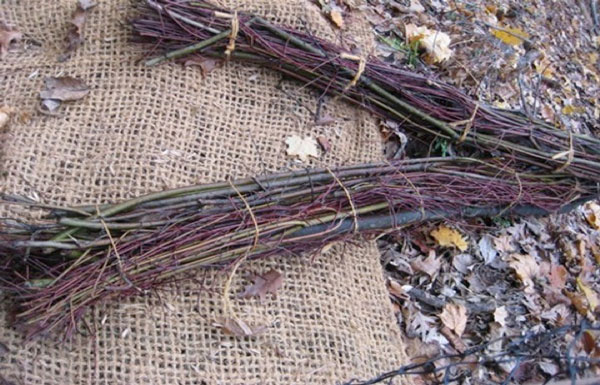Live Fascines

Description
Live fascines are used to protect banks from washout and seepage, particularly at the edge of a stream, where water levels fluctuate moderately. They are dormant branch cuttings bound together into long cylindrical bundles and placed in shallow trenches on slopes to reduce erosion and shallow sliding. Fascines are usually willow branches, but other species such as red-osier dogwood or snowberry can be used. Fascines can also be constructed of plant stems not intended for rooting (known as inert fascines).
Applicability
Live fascines are used from the baseflow elevation and up along the face of an eroded streambank, acting principally to protect the bank toe and bank face. They are also useful over the crown to improve erosion control, infiltration, and other riparian zone functions. The live fascines can also be configured to act as current deflectors and pole drains that collect and transport water (Sotir and Fischenich 2001), and can provide a living filter to intercept and absorb excess nutrients and pollutants before they reach the water. Fascines should be placed in shallow contour trenches on dry slopes and at an angle on wet slopes to reduce erosion and shallow sliding. They are best suited for moist soil conditions.
Effectiveness
As fascines grow roots and top cover, they can improve erosion control, infiltration, and other riparian zone functions (Sotir and Fischenich 2001). Additional benefits resulting from the use of both live and inert fascines include improved fisheries habitat (they provide food and cover when applied close to the edge of the stream), the provision of substrate for an array of aquatic organisms, water quality and aesthetics. However, on steep or long slope lengths, high runoff velocities can undermine live fascines near drainage channels. A significant quantity of plant material is required and it can dry out if not properly installed (USDA-FS 2000).
Costs
According to Sotir and Fischenich (2001), representative construction costs from the year 2000 for live fascines costs range from $10 to $30/ft for 6to 8-in. bundles. Costs for inert fascines can range from $10 to $26/ft for 12-in. bundles and $14 to $30/ft for 18-in. bundles. These estimates include securing devices for installation, twine (for fabrication), harvesting, transportation, handling, fabrication, and storage of the live-cut branch materials, excavation, backfill, and compaction. Costs will vary with design, access constraints, time of year, and regional labor rates. Installation of fascines is relatively simple and does not require large equipment except to slope the bank.
Maintenance
Operation and maintenance requirements are dependent on the velocity, flood frequency, flood stage, timing, and future planned use of the stream. Repairs or protective measures, such as enclosures, may be required until the vegetation becomes well established. Fascines and live stakes were severely damaged by beavers at several bank restoration sites on the Connecticut River. The fascines should be inspected after each flood initially, at least twice a year the first year, and at least once a year afterwards (Sotir and Fischenich 2001).
Design Considerations
- The selection of a site for installation of live fascines should include the consideration of substrate and shade requirements for selected vegetation.
- The site should allow the roots to reach the water table during most of the growing season; and where enough soil is available to allow for root penetration.
- This practice should be used in conjunction with other structural BMPs, such as riprap, and vegetative BMPs for the purpose of maximizing soil erosion control.
- Fascines should not be planted below baseflow levels to prevent them from dying from being submerged too long.
- Live fascine construction should occur during the dormancy period, usually late fall or early spring.
References
MDE. 2000. Maryland’s Waterway Construction Guidelines. The Maryland Department of the Environment Water Management Administration,
http://www.mde.state.md.us/wetlands/guide.html
PADER. 1986. A Streambank Stabilization and Management Guide for Pennsylvania Landowners. Commonwealth of Pennsylvania Department of Environmental Resources (PADER), Office of Resources Management, Harrisburg, PA.
Riley, A. L. 1998. Restoring Streams in Cities: A Guide for Planners, Policymakers and Citizens. Island Press. Washington, DC.
Sotir, R. B. and C. Fischenich. 2001. Live and Inert Fascine Streambank Erosion Control. EMRRP Technical Notes
Collection (ERDC TN-EMRRP-SR-31).
http://www.usace.army.mil/
Streambank and Shoreline Protection Manual. Lake County Stormwater Management Commission, Lake County Planning, Building and Development Department, U.S.D.A. Natural Resources Conservation Service. 2002.
http://www.usace.army.mil/
USDA-FS. 2000. Soil Bioengineering: An Alternative for Roadside Management. United States Department of Agriculture, Forestry Service, Technology and Development Program, San Dimas, California.
www.or.blm.gov/nrst/Reference/Soil%20bioeng.pdf
Recommended Fact Sheets and Resources
Heaton, M. G., R. Grillmayer and J. G. Imhof. 2002. Ontario’s Stream Rehabilitation Manual. Ontario Streams, Belfountain, Ontario.
http://www.ontariostreams.on.ca/
USEPA. Restoration Bi-Weekly Update. United States Environmental Protection Agency, Office of Water. Accessed 7/03/02.
http://www.epa.gov/owow/wetlands/restore/update/